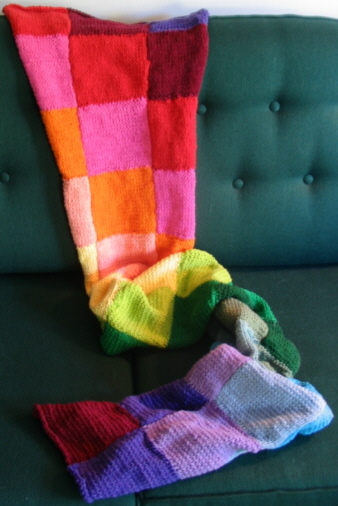
Home
Articles
Awaiting Surgery
Chat
Crafts
Current Events
Fashion
Friends and Family
Fun Stuff
Mailing List
Polls
Profiles
Prostheses
Search
http://flattops.webs.com/
Pot of Gold AfghanIntroduction When a friend of mine went through a horribly difficult time, she began knitting for a hobby. I learned to knit only a year or so before my diagnosis, and decided to take her cue. It did seem therapeutic for me to have something colorful and cheery to work on, and keep my hands and my thoughts working on something productive. With that in mind, I developed an afghan pattern that would be fun, bright, and cheerful. Many knitting projects take a long time to complete, and can be discouragingly intense, with complicated instructions. A blanket is a huge project for a knitter. However, this pattern takes into account the need for "small accomplishments," and not wanting to keep track of rows knitted! It is pieced together with small, independent squares (each is about 5" x 5"), small enough squares to knit in one day. As pieces are finished, they are added to the afghan, making each square an accomplishment that leads to finishing another part of the afghan. My afghan is chromatic, like a rainbow. You can adapt the pattern to make it in any color scheme that you like. For example, how about a checkerboard pattern of lime and emerald green squares? Why chromatic? In the Old Testament, the rainbow came along with a promise from God, after an horrific event (Genesis), a promise that God cared and was there all along. Many Christians take the rainbow as a sign that God is always with us. In Ezekiel 1:28, the rainbow is also noted as being associated with the glory of the Lord ("Like the appearance of a rainbow in the clouds on a rainy day, so was the radiance around Him" (NIV)). For secular purposes, a rainbow can represent a "pot of gold," or blessing, at the end of a journey. Sizing
Before beginning, write down the size afghan you want, in inches. A small size is nice for a shawl or throw blanket, while a larger size can cover a "sick bed" and add cheerful color to a room.
Each finished knitted square is
approximately 5" x 5", so divide each number by 5. Then multiply your two resulting numbers by one another for
the number of squares you will need to knit. Your afghan's height should be a minimum of seven colors, or 30". You will
want to have (in this order): red, orange, yellow, green, blue, violet. If you want the height to be more than
30" (and you probably will!), add in some transitional shades of these colors. For example: pink, lime green,
and light purple.
You'll need: Instructions Cast on 25 stitches in red yarn. Knit a row, purl a row, and repeat until you have a perfect square. This can be determined by folding the knitting up diagonally. Once the corners and sides meet one another, you have a square. Cast off. This is the top left square of your afghan. The purled side is the "right side" and the knit row is the "wrong side." The appearance will be similar to how a sweater looks "different" on either side and "inside out" when it's on the knitted side! Piecing the afghan together is a bit tricky. The colors cascade down chromatically. It is pieced together by height (columns), with the width (rows) naturally increasing as you continue finishing height columns. Sew (with like colored yarn) pieces together, height-wise, in this order: red, orange, yellow, green, blue, violet (remembering to add in the transitional shades where appropriate). When one height column is completed, you will have a chromatic arrangement. The bottom shade on this height row now becomes the top shade of yarn in the next column! For each column, the bottom shade/color becomes the top piece in the next column. The colors will be the same on the diagonal. Continue until the afghan has reached its intended size.
Do you have ideas for articles you'd like to see on the site? Did you write an article you'd like to submit? Be sure to send them in. Thank you! This pattern was made by Melissa, October 2006, for Flattops. It cannot be redistributed and is for personal use only. Flattops is not responsible for anything occurring as a result of using this pattern. |
